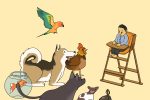Dogs are man’s best friend, a symbol of devotion and the world’s most popular pet. After centuries of domestication, dogs have become an important part of human life, with over half of American households owning at least one dog. With such a long history alongside humans, it is natural that dogs would become part of art and literature. And yet, as much as people love them, dogs in fiction have a high mortality rate.
Many elementary school curriculums include at least one book that prominently features a dog that dies, and there are a lot of books to choose from — “Where the Red Fern Grows,” “Sounder” and “A Dog Called Kitty” are just a few examples. All of them follow this pattern: A boy needs to learn a life lesson. He encounters a dog who teaches him that life lesson and the dog inevitably perishes in a tragic and self-sacrificing way. The boy is sad but can now move forward with his life with the lesson safely tucked under his belt, and, if the author is successful, the reader cries. Arguably the most enduring of these books is “Old Yeller” by Fred Gibson.
Why “Old Yeller” Is Successful
“Old Yeller” came out in 1956 and quickly cemented itself as an American classic when it won the Newberry Medal a year later. The book sets a standard for the many sentimental dog books that followed.
“Old Yeller” neatly fits into the pattern for these kinds of books. The main character is a boy named Travis. Old Yeller, a faithful dog and the novel’s namesake sets an example for Travis, who learns the difference between courage and recklessness. Once Travis learns this lesson, Old Yeller is tragically bitten by a rabid wolf and Travis puts Old Yeller down. Travis mourns but goes forward knowing that he is a better person after knowing Old Yeller. Presumably, this is where the reader cries.
It is a simple story and clearly it resonates with many people, given its accolades. At the time, the Western genre was alive and well, and while “Old Yeller” is certainly not a Western story, it embodies a similar aesthetic and masculine sensibility that would have been familiar to audiences at the time and would have been easy to latch onto. Today, many parents appreciate the morals showcased in “Old Yeller,” such as how Travis learns to take responsibility for his actions. It’s become nostalgic for many parents and teachers, so much so that they are eager to share the book with a new generation.
And, of course, there’s Old Yeller himself. When so many people are fond of dogs, there will be an instinctual attachment to the canine character. Old Yeller doesn’t have the same human baggage that the protagonist does and the audience is free to love him and mourn his death without any arguments about his actions. The emotional connection to Old Yeller is what leads an audience to reread the book and recommend it to others.
“Old Yeller” as a Teaching Tool
Old Yeller, of course, is not the first casualty on the list of fictional dogs. Authors have been killing dogs since the eighth century BC when the Greek poet Homer killed off Odysseus’ dog moments after the pair were reunited after 10 years of separation.
Clearly, humans have been mourning fictional dogs for generations. However, most books do not feature a dog death as a pivotal moment for character growth. In fact, there are many reasons to explain why dogs die in literature. Dogs are cute, have simple motivations and are easy for readers to love. A dog death may be a way for authors to elicit an emotional reaction from a reader, demonstrate a villain’s cruelty or force the protagonist to react.
“Old Yeller” and similar books use dogs and their deaths in a specific way. While Old Yeller is an essential element of the book, the dog himself is not a character. Old Yeller doesn’t have a character arc; he doesn’t change through the course of the story. He is an external influence on Travis and he is merely a tool that sets events in motion and allows the plot to progress. He dies for the same reason. By the end of the book, Travis has learned everything he can from Old Yeller and now needs the opportunity to independently exercise his new life lessons to grow as a character. Tragically, Old Yeller’s death is necessary for Travis’ growth.
Allowing children to learn life lessons by killing fictional dogs is not inherently harmful, however. There are many reasons why an author would choose to use a dog rather than a human character. When teaching children about complex topics like death, it’s often easier to approach it through the distance of fiction and animals. Emotional books like these can also be a tool that allows young readers to feel strong emotions and learn to manage them without having to endure the hardship themselves.
Beyond “Old Yeller”
Turning a fictional dog into a moral is harmless enough, but the same lines of thinking that are acceptable for a dog often surface in other contexts. As students advance through the grades, the assigned literature becomes more complex. There are fewer dogs and more human hardship. The books are meant to inspire thought instead of triggering emotional responses. Even so, some of the aspects of “Old Yeller” are preserved in more complicated books.
Many books feature love interests who die tragically for the sole purpose of motivating the protagonists and shocking the reader. Mentors and parental figures pass away to allow the protagonist to grow as a character. A protagonist’s friend may heroically sacrifice themselves, inspiring change in the main character. In many ways, these characters are dead dogs like Old Yeller, literary tools that show up to teach a lesson before fading away. They might as well be replaced with a dog.

















